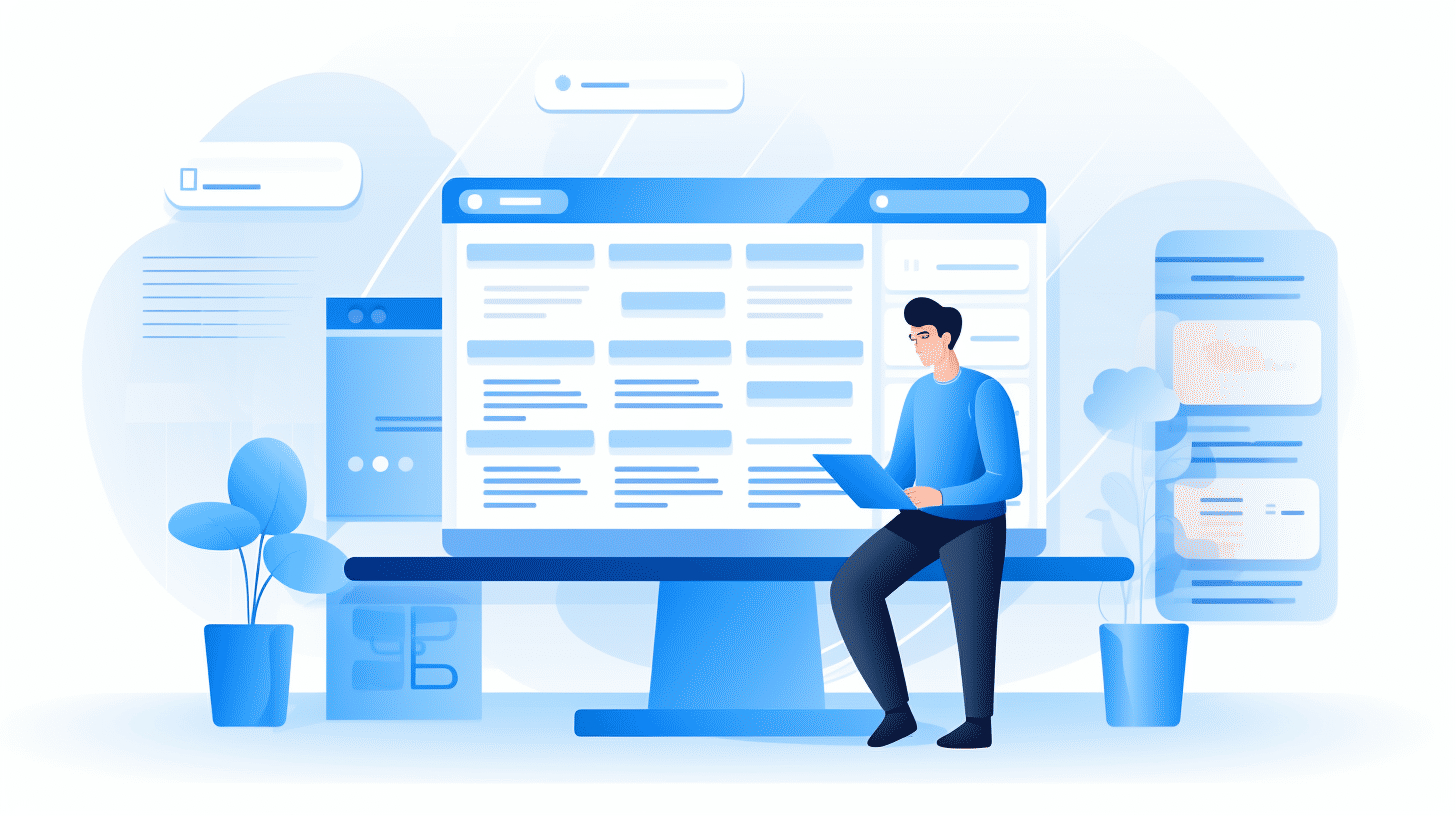在當今快節奏的數位環境中,速度就是一切。無論是加載網站、播放串流影片還是存取訊息,人們都希望事情能夠立即發生。對於 WordPress 網站來說,載入時間緩慢可能會讓訪客感到失望,並會嚴重影響使用者體驗和整體網站效能。這就是為什麼提高載入速度對於 WordPress 網站所有者和管理員至關重要。
在本文中,我們將探討各種策略和技巧,以將您的網站速度提升到新的水平。從優化圖片和選擇可靠的託管服務提供者到更新 WordPress 和實施高級優化技術,我們將涵蓋所有內容。透過實施這些策略,您可以為使用者提供無縫的瀏覽體驗,同時提高您的網站在搜尋引擎排名中的可見度。
因此,如果您準備好提高 WordPress 的載入速度並實現最佳效能,讓我們深入研究並探索將您的網站轉變為閃電般快速的強大網站的各種技術。
加載速度的重要性
🚀 您的網站載入速度是否比天空中飛行的火箭還快?如果沒有,您可能會錯過一些重要的好處。在當今快節奏的網路世界中,載入速度對於決定網站的成功起著至關重要的作用。用戶沒有耐心等待加載緩慢的網站,研究表明,加載時間緩慢會對用戶體驗和轉換率產生不利影響。
轉換率
📊 你知道嗎,載入時間只有 1 秒的網站 高出 3 倍 與那些需要 5 秒鐘才能緩慢加載的網站相比,轉換率如何?這項驚人的發現來自 Portent 進行的一項研究,強調了載入速度和轉換率之間的直接關聯。用戶更有可能造訪載入速度快、效率高的網站並進行購買。
💰 這對您的業務意味著什麼?更快的加載速度可以直接轉化為增加的收入和更高的投資回報。毫無疑問,投資優化網站的載入速度是提高線上業務成功率的明智之舉。
快取插件
💡那麼如何提高網站的載入速度呢?一個有效的解決方案是使用快取插件。快取是一種儲存網站內容臨時版本的技術,使用戶可以輕鬆使用該網站內容,而無需每次都從伺服器檢索它。這可以顯著減少載入時間並帶來更快、更無縫的用戶體驗。
⚡️ 使用快取外掛程式可將載入時間縮短一半,從而立即提升您網站的效能。透過快取靜態檔案(例如 HTML、CSS 和 JavaScript),該外掛程式可確保更有效率、更便捷地向使用者提供這些檔案。因此,您的網站看起來更快捷、反應更快,能夠吸引並留住訪客的注意。
🔐此外,快取外掛程式還可以優化資料庫、縮小 CSS 和 JavaScript,並實現其他增強效能的技術。這種綜合方法可確保您的網站以最佳效率運行,並以最快、最有效的方式向使用者提供內容。
因此,今天就採取一步措施來優化您的網站的載入速度。投資快取插件並為您的用戶提供閃電般的瀏覽體驗,讓他們保持參與並推動轉換。畢竟,在當今競爭異常激烈的網路環境中,分分秒秒都至關重要!
優化影像以提高速度
在當今快節奏的數位世界中,使用者體驗對於任何網站的成功至關重要。為了獲得更好的性能而對網站進行優化最容易被忽視的方面之一就是圖像優化。圖像在網頁設計中扮演著重要的角色,但它們也可能是降低網站速度的主要因素。幸運的是,有兩種技術可用於優化圖像並提高網站速度: 影像壓縮 和 延遲載入.
🖼️ 影像壓縮
當談到網站效能時,大圖像可能是一個真正的瓶頸。它們需要更長的時間來加載,從而增加了頁面加載時間並可能帶來令人沮喪的用戶體驗。影像壓縮是在不顯著影響影像品質的情況下減少影像檔案大小的過程。透過壓縮圖像,您可以顯著減小其檔案大小,從而使其載入速度更快,同時又不犧牲視覺吸引力。
影像壓縮如何運作?
影像壓縮技術的工作原理是從影像檔案中刪除不必要的資料。這可以包括元資料、顏色資訊或冗餘像素。這樣做可以減小檔案大小,讓圖片更容易在網頁上載入。影像壓縮主要有兩種類型:
- 無損壓縮: 該技術可在不影響影像品質的情況下減少檔案大小。無損壓縮非常適合需要高細節等級的影像,例如產品影像或圖形。類似的工具 小PNG 和 JPEG迷你 是無損壓縮的流行選項。
- 有損壓縮: 有損壓縮透過丟棄部分影像資料來減少檔案大小。這會使檔案大小變小,但可能會導致影像品質略有下降。有損壓縮通常用於較大的影像,例如橫幅或英雄影像。流行的有損壓縮工具包括 Kraken.io 和 Compressor.io.
➡️ 延遲加載
延遲載入是另一種可以透過優化圖片載入方式大幅提高網站速度的技術。傳統上,當網頁載入時,該頁面上的所有圖像也會載入。這可能會導致嚴重的延遲,尤其是對於包含大量圖像的頁面。另一方面,延遲加載會推遲圖像的加載,直到真正需要它們為止。
延遲載入如何運作?
延遲載入的工作原理是僅當圖像即將進入使用者視圖時(即,當使用者向下捲動頁面時)才載入圖片。這表示螢幕上未立即顯示的影像將不會被下載,直到需要時才顯示。因此,頁面載入時間減少了,因為最初只載入使用者可見的圖片。
可以使用 JavaScript 庫實現延遲加載,例如 路口觀察員 或者 延遲載入。這些庫提供了一種將延遲載入功能合併到您的網站的簡單方法,從而提高了網站速度和使用者體驗。
請記住,透過壓縮圖片和使用延遲載入技術來優化圖片可以大大提高網站速度。透過減少檔案大小和延遲圖像加載,您可以為用戶創建更快、更有效率的瀏覽體驗。
選擇可靠的託管提供者
🚀 介紹
在建立網站時,選擇可靠的託管服務提供者至關重要。您的託管服務提供者就像您線上形象的基礎。它直接影響您網站的效能、載入速度和整體使用者體驗。那麼,您該如何選擇能夠滿足您需求的合適託管服務提供者呢?別怕,我們會保護你的!
🔍 需要考慮的因素
在眾多的託管服務提供者中,評估不同的因素以確保您做出明智的決定至關重要。請考慮以下情況:
- 正常運作時間和可靠性:尋找能夠保證高正常運作時間的託管服務供應商,理想情況下為 99.9% 或更高,以確保您的網站始終可供訪客存取。沒有人喜歡一個經常宕機或加載緩慢的網站!
- 載入速度:快速的載入時間對於提供無縫的使用者體驗至關重要。選擇使用高效能伺服器並提供快取機製或內容分發網路 (CDN) 來提高載入速度的託管服務提供者。
- 可擴展性:隨著時間的推移,您的網站的流量和資源需求可能會成長。確保您的託管服務供應商提供可擴充性選項,讓您能夠輕鬆升級託管計劃並輕鬆適應增加的流量。
- 客戶支援:當您遇到技術問題或對託管服務有疑問時,一支反應迅速、樂於助人的客戶支援團隊可以發揮重要作用。尋找透過多種管道(例如即時聊天、電子郵件和電話)提供全天候支援的供應商。
- 安全:保護您的網站和用戶資料至關重要。選擇實施強大安全措施的託管服務供應商,例如防火牆、SSL 憑證、定期備份和主動惡意軟體掃描。
💰 成本考慮
雖然優質託管需要付出代價,但找到成本和價值之間的平衡至關重要。考慮以下與成本相關的面向:
- 計劃和定價:探索託管服務提供者的計劃和定價結構。比較不同的供應商,找到能夠提供適合您網站需求的功能和資源的供應商,而無需為不必要的附加元件支付過高的費用。
- 續約率:注意續訂率,因為一些提供者可能會提供介紹折扣,但在續訂時會大幅提高價格。如果您致力於網站的長久發展,請考慮長期計劃。
- 退款保證:可靠的託管服務提供者應該提供滿意度保證。檢查他們是否提供退款保證,以便您可以無風險地測試他們的服務。
👥 顧客評論和推薦
不要只聽託管服務提供者的說法。尋求來自可靠來源的客戶評論和建議,以深入了解現實生活中的體驗。請考慮以下因素:
- 可靠性和正常運作時間
- 支持品質
- 載入速度
- 可擴充性和靈活性
☑️ 結論
選擇可靠的託管服務提供者對於提高載入速度、確保高正常運行時間和提供卓越的使用者體驗至關重要。在做出決定之前,請評估正常運作時間、載入速度、可擴充性、客戶支援、安全性和成本等因素。不要忘記考慮客戶的評論和建議,以獲得全面的視角。請記住,投資可靠的託管服務提供者就是對您網站成功的投資!
更新 WordPress 以獲得更好的效能

在當今數位時代,擁有一個表現良好的網站對於企業和個人來說都至關重要。當今最受歡迎的內容管理系統之一是 WordPress,它以易用性和靈活性而聞名。但是,與其他軟體一樣,WordPress 需要定期更新以確保最佳效能和安全性。外掛程式和 PHP 更新對於保持您的 WordPress 網站順利運行都起著至關重要的作用。讓我們仔細看看為什麼更新這些元素至關重要以及它如何使您的網站受益。
插件更新
外掛程式是增強 WordPress 網站功能的附加元件。它們允許您自訂您的網站並添加新功能,而無需從頭開始編寫程式碼。定期更新插件非常重要,原因如下:
- 安全: 外掛開發人員經常發布更新來修補漏洞並保護您的網站免受潛在威脅。未能更新外掛程式可能會導致您的網站容易受到攻擊,危及敏感資料並損害您的線上聲譽。
- 相容性: WordPress 隨著時間的推移不斷發展,推出新功能和改進。外掛程式更新可確保您的網站與最新的 WordPress 版本相容,避免任何衝突或功能問題。
- 表現: 過時的外掛程式會降低您的網站速度,影響用戶體驗和搜尋引擎排名。外掛程式更新通常包括效能增強,確保您的網站保持快速且反應迅速。
- 錯誤修復: 開發人員發布更新來修復插件中任何已知的錯誤或問題。透過定期更新插件,您可以確保訪客獲得流暢、無錯誤的使用者體驗。
PHP 更新
在幕後,WordPress 依靠 PHP 程式語言來運作。 PHP 更新為您的 WordPress 網站帶來了多種好處:
- 安全: 與插件一樣,PHP 版本可能包含可能被駭客利用的漏洞。更新至最新的 PHP 版本可保護您的網站免受潛在的安全漏洞。
- 表現: PHP 更新通常伴隨著效能改進,讓您的 WordPress 網站更快、更有效率。這可以縮短頁面載入時間,增強使用者體驗並鼓勵訪客在您的網站上停留更長時間。
- 相容性: 隨著 WordPress 和外掛程式的發展,它們可能需要更新的 PHP 版本才能正常運作。透過更新至最新的 PHP 版本,您可以確保您的網站與最新的軟體版本相容,並且可以利用新功能和增強功能。
- 支援和維護: 不建議使用舊版的 PHP,因為它們可能不再獲得 PHP 社群的支援和維護。透過隨時了解 PHP 更新,您可以受益於持續的支援並存取新的 PHP 功能。
值得注意的是,在更新外掛程式或 PHP 之前,建議備份您的 WordPress 網站,以避免任何潛在的資料遺失或網站停機。此外,在繼續更新之前,請確保您的外掛程式和主題與最新的 WordPress 和 PHP 版本相容。
透過定期更新您的 WordPress 網站(包括外掛程式和 PHP),您可以確保更好的效能、增強的安全性、與最新軟體版本的兼容性以及改善的用戶體驗。忽略這些更新可能會導致潛在的安全風險、效能問題和軟體衝突。保持積極主動並保持您的 WordPress 網站更新,以獲得高效能網站帶來的好處!
利用內容傳遞網路 (CDN)
想像一下:您花了無數的時間來打造一個漂亮的 WordPress 網站,其中包含有價值的內容、令人驚嘆的視覺效果和用戶友好的導航。您為您的創作感到自豪,您應該這樣做!但有一個問題——您的網站載入速度很慢,訪客很快就會失去耐心。您可以做些什麼來解決這個困境並確保為您的受眾提供無縫的用戶體驗?
輸入內容傳遞網路 (CDN)。實施 CDN 可以幫助您在全球加速您的 WordPress 網站,並快速且有效率地向訪客提供內容。無論您是針對特定區域的客戶還是全球受眾的本地業務,CDN 都可以為您的網站效能創造奇蹟。
那麼,CDN 到底是什麼呢?簡單來說,CDN 是位於世界各地不同地理位置的伺服器網路。這些伺服器儲存您網站內容的快取副本,包括圖像、影片、樣式表和腳本。當訪客請求您的網站時,CDN 會從最靠近其位置的伺服器提供內容,從而減少延遲並縮短載入時間。
以下是為您的 WordPress 網站使用 CDN 的一些主要好處:
- 提高網站速度:透過從距離訪客最近的伺服器提供內容,CDN 顯著減少了資料需要傳輸的距離,從而縮短了載入時間。這意味著無論訪客是從紐約還是東京訪問您的網站,他們都不必等待很長時間才能看到您的內容。
- 全球影響力:透過 CDN,您的網站可以覆蓋世界各地的用戶,不受任何地理限制。無論您的受眾位於何處,他們都可以快速且無縫地訪問您的網站。
- 減少伺服器負載:當您實作 CDN 時,您的伺服器負載將分佈在多個伺服器位置。這意味著 CDN 處理了很大一部分流量,減輕了原始伺服器的壓力並降低了高流量期間崩潰或減速的風險。
- 改進的搜尋引擎優化:網站速度是搜尋引擎排名的關鍵因素。更快的網站可以提供更好的用戶體驗,Google 等搜尋引擎在確定排名時會考慮這一點。透過利用 CDN 來加速您的 WordPress 網站,您可以提高在搜尋結果中排名更高和吸引更多自然流量的機會。
簡而言之,整合內容傳遞網路 (CDN) 可以為您的 WordPress 網站的效能創造奇蹟。從提高網站速度到擴大全球影響力和增強搜尋引擎優化 (SEO),其好處是不可否認的。因此,如果您想提供無縫的用戶體驗並在競爭中保持領先,那麼是時候考慮為您的網站實施 CDN 了。
減少膨脹以提高速度
在當今快節奏的數位世界中,速度就是一切。用戶希望網站能夠快速加載,如果加載速度慢,他們會毫不猶豫地點擊後退按鈕並轉到下一個選項。導致網站速度變慢的主要原因之一是網站臃腫,也就是那些拖累網站速度的不必要的包袱。但別擔心,您可以採取一些措施來減少這種膨脹並優化您的網站,以實現閃電般的快速性能。在本節中,我們將探討實現此目的的有效方法:消除未使用的外掛程式、媒體和 JavaScript 檔案。
刪除未使用的插件
- 外掛程式是可以增強網站功能的絕佳工具,但它們也可能造成網站過度膨脹。花點時間評估您已安裝的所有插件,並問問自己每個插件是否真正必要。有些插件可能是為了特定目的而安裝的,但由於其他插件的存在,它們不再相關或冗餘。刪除任何不必要的插件以減輕您網站的負載。
清理未使用的介質
- 隨著時間的推移,媒體文件很容易在您的網站上堆積。不再使用的圖像、視訊和音訊檔案會佔用寶貴的空間並導致網站臃腫。使用媒體清理工具或手動檢查媒體庫以識別並刪除不再需要的檔案。不要忘記檢查重複文件並透過壓縮來優化剩餘的文件,但不要犧牲太多的品質。
最小化 JavaScript 文件
- JavaScript 是一種強大的程式語言,可以在現代網站上實現廣泛的互動功能。然而,過多或未使用的 JavaScript 檔案會嚴重降低您的網站速度。花點時間檢查您的 JavaScript 檔案並確定哪些檔案對於您的網站功能至關重要。將多個 JavaScript 檔案合併為一個檔案並將其最小化可以幫助減少 HTTP 請求並縮短載入時間。
透過消除未使用的插件、媒體和 JavaScript 文件,您可以顯著減少網站的膨脹並提高其整體速度。請記住,速度是用戶體驗和搜尋引擎優化的重要因素。因此,請花時間定期整理您的網站,享受更精簡、更快速、更有效率的線上狀態帶來的好處。 🚀
優化 HTML、CSS 和 JavaScript
在當今快節奏的數位世界中,網站表現至關重要。用戶變得越來越沒有耐心,加載緩慢的網站會導致高跳出率並失去潛在客戶。提高網站效能的一個有效方法是透過優化 HTML、CSS 和 JavaScript 檔案。
最小化🚀
優化這些文件的一種流行技術是 最小化。縮小是指透過刪除不必要的字元(例如註解、空格和換行符)來減少檔案大小的過程。這樣做,檔案變得更小,載入速度更快,從而改善使用者體驗。
以下是有關縮小的一些要點:
- 減小檔案大小: 縮小檔案大小可以刪除多餘的字符,從而顯著減小檔案大小。這對於網路連線速度較慢的使用者或透過行動裝置造訪網站的使用者尤其有益。
- 更快的載入時間: 當網頁瀏覽器請求檔案時,它必須從伺服器下載該檔案。文件較小時,下載時間減少,從而加快載入時間。這至關重要,因為研究表明,用戶往往會放棄加載時間超過幾秒鐘的網站。
- 改進緩存: 縮小在瀏覽器快取中也發揮作用。當使用者造訪網站時,瀏覽器會將某些檔案儲存在其快取中,以便更快地進行後續存取。透過最小化文件,瀏覽器可以更有效地快取它們,從而減少將來再次下載它們的需要。
根據您的特定需求,可以對 HTML、CSS 和 JavaScript 檔案單獨或全部進行縮小化。有幾種工具和外掛程式可以在開發過程中自動縮小這些文件。
透過壓縮優化 HTML、CSS 和 JavaScript 文件,網站擁有者可以大幅縮短載入時間並增強整體使用者體驗。在當今競爭激烈的數位環境中,每分每秒都至關重要,優化這些檔案是實現高效、高效能網站的重要一步。
您是否知道縮小檔案大小可以減少檔案大小並提高網站效能?了解有關優化 HTML、CSS 和 JavaScript 的更多信息 在这里,.
選擇輕量級 WordPress 主題
⚡ 使用輕量級、快速的 WordPress 主題可以加快載入速度、改善用戶體驗並在搜尋引擎結果中獲得更好的排名。 ⚡
說到 WordPress 主題,人們很容易被漂亮的設計和華麗的功能所吸引。然而,重要的是要記住,您選擇的主題對您網站的效能和功能起著至關重要的作用。輕量級的 WordPress 主題可以提供除了美觀之外的眾多好處,使其成為任何網站所有者的明智選擇。
極品飛車
在當今快節奏的數位世界中,速度就是一切。用戶希望網站能夠快速加載,而 Google 等搜尋引擎在確定搜尋排名時會考慮網站速度。輕量級的 WordPress 主題可以顯著提高您的網站的載入速度,確保訪客不必等待您的內容出現。
以下是輕量級 WordPress 主題可以提高載入速度的一些原因:
- 最佳化程式碼:輕量級主題採用最少且精簡的程式碼構建,減少了您的網站呈現網頁所需的工作量。
- 功能較少:雖然某些主題帶有大量的花俏功能,但輕量級主題則著重於基本要素。缺少額外的功能意味著需要處理和載入的程式碼更少,從而縮短了載入時間。
- 高效設計:輕量主題優先考慮效率和效能,從而產生更精簡的 CSS 和 JavaScript 檔案。這種優化的設計可使您的網站加載更快、更流暢。
透過選擇輕量級主題,您可以讓您的網站在載入速度方面佔據先機,確保您的訪客能夠以最短的等待時間存取您的內容。
增強使用者體驗👥
快速載入的網站不僅有利於您的搜尋引擎排名,還能改善整體使用者體驗。當使用者造訪網站時,他們希望快速輕鬆地找到他們想要的資訊。輕量級的 WordPress 主題有助於提供流暢、高效的瀏覽體驗,讓訪客保持參與度和滿意度。
以下是輕量級主題增強使用者體驗的幾種方法:
- 快速導航:透過更快的載入時間,您的訪客可以無縫瀏覽您的網站。這意味著他們可以從一個頁面移動到另一個頁面,訪問選單,並與您的網站元素進行交互,而不會出現延遲或中斷。
- 響應式設計:許多輕量級主題優先考慮行動響應能力,確保您的網站在任何裝置上都能正常顯示和運作。隨著越來越多的用戶透過智慧型手機和平板電腦造訪網站,這一點變得越來越重要。
- 直覺的介面:輕量級主題通常具有簡單直覺的設計,方便使用者找到所需內容。透過消除不必要的元素並專注於可讀性,輕量級主題可以增強使用者參與度。
SEO 優勢
搜尋引擎優化(SEO)對於增加您網站的自然流量至關重要。輕量級的 WordPress 主題可以透過多種方式對你的 SEO 工作產生正面影響:
- 更快的網站索引:搜尋引擎根據網站的載入速度來抓取和索引網站。輕量級主題可以幫助搜尋引擎機器人快速存取和索引您的頁面,從而提高搜尋引擎的可見性。
- 降低跳出率:載入緩慢的網站通常會導致高跳出率,用戶會很快離開您的網站。透過使用快速加載的輕量級主題,您可以留住訪客更長時間,並向搜尋引擎發送有關內容相關性和品質的正面訊號。
- 行動友善設計:隨著行動搜尋的重要性日益增加,搜尋引擎在排名中優先考慮適合行動裝置的網站。選擇具有響應式設計的輕量級主題可確保您的網站針對行動裝置進行了最佳化,從而提高您在行動搜尋結果中排名更高的機會。
總而言之,選擇輕量級的 WordPress 主題不僅僅是為了美觀;這是一個策略決策,可能會對您網站的效能、使用者體驗和搜尋引擎排名產生重大影響。透過優先考慮速度、效率和簡單性,輕量級主題可以幫助您的網站在數位領域中脫穎而出,並為您的訪客提供愉快的瀏覽體驗。因此,請花時間研究並選擇符合您網站目標和目的的輕量級 WordPress 主題。您的用戶和搜尋引擎將會感謝您!
🌟 專業提示:如果您不確定在哪裡可以找到輕量級的 WordPress 主題,請查看官方 WordPress 主題目錄或 ThemeForest 等信譽良好的主題市場。尋找具有正面使用者評價、定期更新和良好支援選項的主題,以確保您獲得適合網站可靠且高品質的主題。
啟用 GZIP 壓縮
在當今快節奏的數位世界中,網站載入速度在用戶體驗和搜尋引擎優化中起著至關重要的作用。網站載入緩慢不僅會讓訪客感到沮喪,而且還可能失去潛在客戶。提高網站載入速度的一個有效方法是啟用 GZIP 壓縮。
什麼是 GZIP 壓縮?
GZIP 壓縮是一種在檔案(例如 HTML、CSS 和 JavaScript)傳輸到使用者瀏覽器之前減小其大小的方法。它透過刪除冗餘資訊和壓縮剩餘數據來實現這一點。壓縮檔案一旦到達使用者的瀏覽器,就會被解壓縮,進而縮短載入時間。
啟用 GZIP 壓縮的好處
啟用 GZIP 壓縮可以為您的網站帶來多種好處:
- 更快的頁面載入速度: 透過減少檔案大小,GZIP 壓縮可以更快地傳輸和呈現網頁。這會改善用戶體驗並提高參與度。
- 減少頻寬使用: 文件越小,意味著需要從伺服器傳輸到使用者瀏覽器的資料越少。對於網路連線受限或速度較慢的用戶來說,這尤其有益。
- 改進的搜尋引擎優化: 網站速度是搜尋引擎優化的關鍵因素。谷歌等搜尋引擎在對網站進行排名時會考慮載入速度。透過啟用 GZIP 壓縮,您可以提高網站的載入速度並可能提高其搜尋引擎排名。
如何啟用 GZIP 壓縮
在您的網站上啟用 GZIP 壓縮並不一定是一個複雜的過程。基本步驟如下:
- 檢查 GZIP 壓縮是否已啟用: 在進行任何更改之前,值得檢查您的伺服器上是否已啟用 GZIP 壓縮。您可以使用線上工具或檢查您網站的 HTTP 回應標頭來查看 GZIP 壓縮是否處於活動狀態。
- 配置 GZIP 壓縮: 如果尚未啟用 GZIP 壓縮,則需要在伺服器上進行設定。這通常可以透過伺服器的設定檔完成。例如,如果您使用的是 Apache,則可以透過修改
.htaccess文件。 - 測試 GZIP 壓縮: 啟用 GZIP 壓縮後,必須測試它是否正常運作。 GTmetrix 或 Google PageSpeed Insights 等線上工具可以分析您網站的效能並提供有關 GZIP 壓縮的回饋。
請記住,如果您對自己進行這些更改沒有信心,最好諮詢網站開發人員或託管服務提供者以尋求協助。
專業提示: 除了啟用 GZIP 壓縮之外,您還可以透過縮小 HTML、CSS 和 JavaScript 檔案來進一步優化網站的檔案大小。壓縮會刪除不必要的字符,例如空格和註釋,而不會改變程式碼的功能。
透過將 GZIP 壓縮納入您的網站基礎設施,您可以顯著改善載入時間、增強用戶體驗並潛在地提高您的搜尋引擎排名。不要讓加載緩慢的頁面阻礙您的線上成功;立即利用 GZIP 壓縮的強大功能。
清理資料庫以提高效能
保持您的網站順利運作對於提供積極的用戶體驗至關重要。一個經常被忽視但會對網站效能產生重大影響的領域是資料庫。定期清理網站的資料庫有助於提高效能和速度,確保網站能夠為訪客快速且有效率地載入。
為什麼要清理資料庫?
隨著時間的推移,您的網站資料庫可能充斥著不必要的數據,例如未使用的外掛程式或主題、垃圾評論、舊版本和其他臨時文件。這些數據的累積可能會減慢您的網站速度並影響其整體效能。清理資料庫會刪除這些多餘的數據,使您的網站更有效率地運作。
您能清潔什麼?
清理資料庫包括識別和刪除不再需要的不必要資料。清理資料庫時可以重點放在以下幾個方面:
- 未使用的外掛程式和主題:刪除任何不再使用的外掛程式或主題。這些文件可能會佔用資料庫中的寶貴空間。
- 過期或垃圾評論:刪除垃圾評論並刪除任何不再相關或必要的評論。
- 帖子修訂:如果您定期修改和更新您的帖子,您的資料庫可能會儲存每個帖子的多個版本。清除舊版本可以釋放資料庫空間。
- 優化資料庫表:隨著時間的推移,資料庫表會變得碎片化,從而降低查詢速度。優化資料庫表有助於透過更有效地重新排列和組織資料來提高效能。
如何清理資料庫
清理資料庫並不一定是一項艱鉅的任務。您可以遵循以下步驟來保持資料庫處於最佳狀態:
- 備份資料庫: 在進行任何更改之前,必須備份資料庫,以確保在出現任何問題時擁有資料的副本。
- 刪除未使用的外掛和主題: 瀏覽您的外掛程式和主題清單並刪除不再需要或使用的外掛程式和主題。
- 刪除垃圾郵件和不必要的評論: 使用外掛程式或手動從您的網站刪除任何垃圾或不相關的評論。
- 清理貼文修訂: 考慮使用外掛程式或執行資料庫查詢從資料庫中刪除舊的貼文修訂。
- 優化資料庫表: 使用外掛程式或執行最佳化查詢來整理和組織資料庫表。
乾淨資料庫的好處
維護乾淨且優化的資料庫可以為您的網站帶來多種好處:
- 改進的性能: 刪除不必要的資料並優化資料庫可以顯著提高網站的速度和整體效能。
- 更好的使用者體驗: 更快的載入速度可以帶來更好的使用者體驗,降低跳出率並鼓勵訪客停留並瀏覽您的網站。
- 增強安全性: 清理資料庫可減少潛在的漏洞並降低資料外洩的風險。
- 高效率資源利用: 乾淨的資料庫需要更少的資源來運行,從而減少伺服器負載並優化資源使用。
定期清理網站的資料庫應該成為網站維護工作的一部分。透過保持資料庫整潔,您可以確保您的網站為訪客提供無縫、快速的體驗。因此,花點時間清理您的資料庫並享受提高效能和使用者滿意度的好處。
優化圖像檔案並實現快取機制
談到網站效能,優化圖像檔案和實施快取機制是至關重要的步驟。這些策略可以顯著改善頁面載入時間並增強整體使用者體驗。在本節中,我們將討論使用響應式圖像和優化檔案格式的重要性,以及快取機制的好處。
響應式影像
在當今的數位環境中,使用者透過具有不同螢幕尺寸的各種裝置造訪網站,因此確保圖像在所有平台上都能正確顯示至關重要。響應式圖像是解決這個問題的方法。它們會根據裝置的螢幕解析度自動縮放和調整大小,提供最佳的觀看體驗。
以下是優化影像響應性時需要考慮的一些關鍵事項:
- 文件大小: 較大的圖像檔案會減慢頁面的載入時間。透過壓縮影像來減小檔案大小,但不影響視覺品質。
- 文件格式: 為您的影像選擇合適的文件格式。對於照片,使用 JPEG 格式,而 PNG 格式適合圖形和插圖。
- 圖片尺寸: 提供不同尺寸和解析度的影像的不同版本。這樣,瀏覽器就可以選擇最適合使用者裝置的版本,而無需浪費頻寬和處理能力來下載和調整大影像的大小。
請記住,使用適當的文件格式、尺寸和壓縮技術可以大大提高網站圖像的效能。
快取機制
快取機制涉及將檔案或資料暫時儲存在使用者的瀏覽器或中間伺服器上。這樣,後續的頁面存取就可以檢索這些儲存的文件,從而減少每次從伺服器取得它們的需求。這顯著提高了載入時間並減少了伺服器負載。
以下是一些值得考慮實施的快取機制:
- 瀏覽器快取: 指示使用者瀏覽器快取靜態檔案(例如圖像、CSS 和 JavaScript 檔案)會對效能產生重大影響。透過設定適當的快取策略,這些檔案可以儲存在使用者的裝置上,從而加快後續造訪的頁面載入時間。
- 內容傳遞網路(CDN): CDN 是地理分佈在不同區域的伺服器網路。當使用者要求檔案時,CDN 會從距離使用者位置最近的伺服器傳送檔案。這減少了延遲並提高了效能。 CDN 還具有內建快取機制,進一步優化內容傳送。
- 伺服器端緩存: 實作伺服器端快取技術(例如使用快取外掛程式或 HTTP 快取標頭)也可以提高網站效能。這些快取機制儲存產生的 HTML 檔案或資料庫查詢結果,減少了每個訪客重新產生內容的需要。
透過利用快取機制,您可以減少伺服器的負載,最大限度地減少網路請求,並透過更快地傳遞內容來增強用戶體驗。
你可知道? 根據谷歌的一項研究,如果網站加載時間超過 3 秒,53% 的行動用戶會放棄該網站。優化圖像檔案並利用快取機制可以顯著減少載入時間並有助於留住網站上的使用者。
總而言之,使用響應式設計技術、文件壓縮和適當的文件格式優化圖像文件,並結合實施快取機制,可以對網站效能產生深遠的影響。這些策略不僅可以提高頁面載入時間,而且還有助於提供更流暢的整體使用者體驗。因此,不要忽視優化圖像檔案和實施快取機制的重要性,以確保您的網站為訪客提供快速且引人入勝的體驗。
監控和測量網站速度
說到網站效能,速度很重要。網站載入緩慢會導致用戶失望並導致企業失去機會。這就是為什麼監控和測量網站速度對於任何網站所有者或開發人員至關重要。
透過仔細檢查特定指標,您可以深入了解您的網站載入速度,並確定潛在的改進領域。衡量網站速度的兩個常用關鍵指標是首次內容繪製(FCP)和總阻止時間(TBT)。
首次內容繪製 (FCP)
FCP 是指瀏覽器渲染網頁第一部分內容所需的時間。它衡量用戶訪問您的網站時在螢幕上看到有意義的內容的速度。簡單來說,FCP 表示從使用者角度感知的載入速度。
擁有快速的 FCP 可以顯著影響整體用戶體驗,因為它會讓訪客知道您的網站正在快速加載。這可以降低跳出率並增加用戶參與度。監控您網站的 FCP 可以幫助您識別效能問題並進行必要的最佳化以增強使用者體驗。
總阻塞時間 (TBT)
TBT 衡量網頁實現互動所需的時間。它表示從首次內容繪製 (First Contentful Paint) 到瀏覽器對使用者輸入做出回應之間的持續時間。此指標對於評估使用者與您的網站互動的速度至關重要。
高 TBT 可能會導致令人沮喪的使用者體驗,因為訪客可能需要等待更長時間才能讓網站回應他們的操作,例如點擊按鈕或填寫表格。透過監控 TBT,您可以識別導致互動延遲的瓶頸並採取措施優化您網站的效能。
🔍 你可知道?
- Google 的核心網路生命力計畫建議網站的 FCP 應低於 1.25 秒,TBT 應低於 300 毫秒,以獲得最佳使用者體驗。
監控首次內容繪製和總阻塞時間指標可以深入了解您網站的載入速度,幫助您確定需要改進的領域並增強整體使用者體驗。透過優化這些指標,您可以確保您的網站快速加載並為您的訪客提供無縫的瀏覽體驗。
在下一部分中,我們將探討一些監控和測量網站速度的實用策略和工具。
進階優化技術
在當今的數位環境中,網站和線上平台在連接企業和客戶方面發揮著不可或缺的作用,優化網站效能已變得至關重要。頁面載入緩慢會導致高跳出率並降低使用者滿意度。為了應對這些挑戰,可以採用先進的最佳化技術來提高網站速度和整體效能。能夠產生重大影響的三種技術是 CDN 實作、Memcached 利用和 HTTPS 配置。
CDN 實施
一個 內容傳遞網路 (CDN) 是一個策略性地分佈在世界各地的分散式伺服器網路。透過在這些伺服器上儲存網站內容的快取副本,CDN 可以從距離用戶最近的伺服器向用戶提供內容。這種接近性可以最大限度地減少延遲並縮短頁面載入時間。
實施 CDN 的好處包括:
- 更快的頁面載入速度: CDN 的分散特性確保使用者可以從距離其位置最近的伺服器存取內容,從而減少資料需要傳輸的距離並減少載入時間。
- 提高可用性: CDN 有助於將網站流量分配到多個伺服器,從而減輕單一伺服器的壓力並提高網站可用性。
- 改進的可擴展性: CDN 旨在處理大量流量,使其成為流量突然激增的網站的理想解決方案。
Memcached 利用率
記憶體快取 是一個高效能、分散式記憶體物件快取系統。它使網站能夠將經常訪問的資料儲存在記憶體中,從而減少重複資料庫查詢的需要。透過在記憶體中快取數據,網站可以顯著加快動態內容生成並為用戶提供更快的回應時間。
使用 Memcached 的好處包括:
- 減少資料庫負載: 透過在記憶體中快取經常存取的數據,網站可以減輕資料庫的負載,提高整體效能和可擴展性。
- 更快的資料檢索: 由於 Memcached 將資料儲存在記憶體中而不是查詢資料庫中,因此檢索快取資料的速度要快得多,從而可以縮短網站訪客的回應時間。
- 改進的使用者體驗: 更快的資料檢索和減少的資料庫負載可帶來更流暢、更快回應的使用者體驗,從而提高使用者滿意度和參與度。
HTTPS 設定
在資料安全和隱私至關重要的時代,配置您的網站以使其能夠 HTTPS (HTTP 安全)至關重要。 HTTPS 利用 SSL(安全通訊端層)或 TLS(傳輸層安全性)協定加密網站和使用者瀏覽器之間傳輸的數據,確保通訊安全。
HTTPS 設定的好處包括:
- 資料加密: HTTPS 加密敏感用戶數據,例如登入憑證或付款信息,使未經授權的一方無法讀取,從而降低資料外洩的風險。
- 增強信任和可信度: 隨著對網路安全的日益重視,擁有安全的 HTTPS 連線可以讓用戶放心,他們的資料受到保護。這種信任可以對使用者對您的網站和品牌的看法產生積極的影響。
- SEO優勢: 搜尋引擎(例如 Google)將 HTTPS 視為排名訊號。採用 HTTPS 配置的網站往往在搜尋結果中排名較高,從而提高知名度和自然流量。
透過實施 CDN、啟用 Memcached 並將您的網站配置為透過 HTTPS 運行,您可以顯著提高網站效能、改善用戶體驗並在當今競爭激烈的數位領域保持領先地位。對於任何希望最大限度發揮其線上潛力的企業來說,這些先進的優化技術都是必不可少的。 🚀
執行效能測試並分析結果
為了確保您的 WordPress 網站發揮最佳效能,定期執行效能測試並分析結果至關重要。這些測試將為您提供有關網站速度和整體效能的寶貴見解,讓您確定任何需要改進的領域。透過進行這些測試,您可以優化您的網站,以提供快速、無縫的使用者體驗。那麼,讓我們深入了解運行效能測試和分析結果的過程。
效能測試的類型
您可以進行多種類型的效能測試來評估 WordPress 網站的速度和效能。以下是一些常用的測試:
- 負載測試: 此測試模擬大量使用者流量來評估您的網站在高負載下的表現。它可以幫助您識別潛在的瓶頸並確定您的網站是否可以處理大量並髮用戶。
- 頁面載入測試: 此測試測量您的網頁載入所需的時間。它提供有關您網站上各個頁面性能的寶貴信息,使您能夠識別需要優化的任何加載緩慢的頁面。
- 壓力測試: 此測試透過模擬大量的流量來將您的網站推向極限。它可以幫助您了解您的網站在極端條件下的反應以及它是否能夠保持穩定性和效能。
- 資料庫效能測試: 此測試重點關注您的 WordPress 資料庫的效能。它可以幫助您識別可能影響網站整體速度的任何慢查詢或瓶頸。
分析結果
一旦您完成了效能測試,請就該分析結果並做出必要的改進。以下是有效分析資料的方法:
- 識別效能瓶頸: 尋找任何可能減慢網站速度的效能瓶頸。這可能包括頁面載入緩慢、伺服器回應時間過長或資料庫查詢過多。
- 優化資源使用: 分析資源使用數據來確定可以優化伺服器資源使用情況的任何領域。這可能涉及優化映像、減少檔案大小或實施快取機制。
- 優先修復: 根據已發現的問題對您網站效能的影響,確定其優先順序。首先集中精力解決最關鍵的問題,以對整體速度和使用者體驗產生最大影響。
- 測試和監控: 做出必要的改進後,再次執行效能測試以確保您的最佳化達到了預期的效果。持續監控您網站的效能以識別可能出現的任何新問題。
請記住,執行效能測試和分析結果應該是一個持續的過程。定期監控 WordPress 網站的速度和效能將幫助您在問題影響使用者體驗之前發現並解決任何問題。透過主動的優化方法,您可以確保您的網站保持快速、高效,並讓訪客感到愉快。
常見問題解答
- 有哪些有效的方法可以提高WordPress網站的載入速度?
提高 WordPress 網站載入速度的一些有效方法包括優化圖片、使用快取外掛程式、最小化 CSS 和 JavaScript 檔案、啟用壓縮以及選擇可靠的託管服務提供者。
- 我的 WordPress 網站需要快取外掛嗎?
是的,強烈建議使用快取外掛來提高 WordPress 網站的載入速度。快取外掛程式會產生網頁的靜態 HTML 文件,從而減少伺服器負載並有助於更快地向訪客提供內容。
- 如何優化圖像有助於提高載入速度?
優化影像包括在不影響品質的情況下減小其檔案大小。這可以透過將圖像調整為適當的尺寸、使用 TinyPNG 或 Smush 等工具壓縮它們以及使用延遲加載僅加載出現在用戶螢幕上的圖像來實現。
- 選擇可靠的託管服務提供者對網站載入速度有何影響?
選擇具有良好伺服器基礎架構和快速回應時間的可靠託管服務供應商對於提高網站載入速度至關重要。快速的伺服器可確保快速將您的網站內容傳遞給訪客,從而帶來更好的使用者體驗。
- 為了加快 WordPress 網站的速度,是否有必要最小化 CSS 和 JavaScript 檔案?
透過刪除不必要的程式碼、合併和壓縮來最小化 CSS 和 JavaScript 文件,可以顯著減少文件大小,從而加快載入時間。這種優化技術有助於提高網站速度和效能。



















